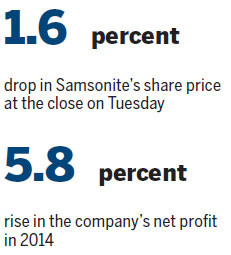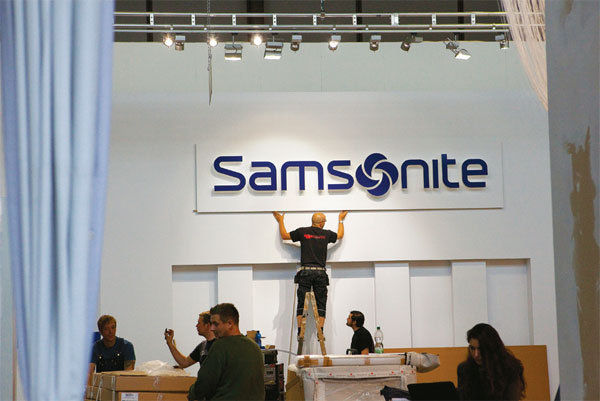Samsonite eyes mainland market for fast growth
Updated: 2015-03-18 06:27
By Emma Dai in Hong Kong(HK Edition)
|
|||||||||
|
With an eye on the mainland market, Samsonite plans to promote its non-travel products. Krisztian Bocsi / Bloomberg |
Global travel goods manufacturer and retailer Samsonite International SA says it's confident of maintaining double-digit sales growth this year and overcoming exchange risks with a stretched product line and strong performance in the mainland market through online expansion.
The company reported on Tuesday its 2014 net profit rose by 5.8 percent on year to $186.3 million, while group turnover soared 15.4 percent from a year ago to a record high of $2.35 billion.
Excluding foreign currency effects, all four of the group's regions recorded double-digit growth in net sales. Led by 18.7-percent growth in China, revenue in Asia rose by 18 percent to $892.3 million, representing about 40 percent of the group's total income. North America gained 22.9 percent, while Europe and Latin America booked 10.4 percent and 15.7 percent increase in sales, respectively, Samsonite's annual report shows.
The company pins its future on diversification in both product portfolio as well as distribution channels, said Ramesh Tainwala, the group's chief executive officer. "We are confident of delivering double-digit growth in constant currency base in the next few years."
In terms of rising currency risks, especially the euro depreciating against a stronger US dollar this year, Tainwala said Samsonite will not hesitate to raise prices of its products as it enjoys pricing power as a market leader. Falling oil prices will also help lower production costs.
Samsonite aims to boost the contribution of non-travel products to 50 percent in the medium term, whereas travel products represented 70.4 percent, or $138.6 million, of the group's total revenue last year.
Simultaneously, apart from whole selling, the company plans to lean to higher retail sales through e-commerce and brick-and-mortar chains - from 20.2 percent to more than half. Direct distribution is to protect margin, Tainwala said.
The suitcase maker made three acquisitions in 2014 - expanding footprint to female-targeted luggage products, iPhone cases and outdoor backpacks. It closed another deal in February by buying Rolling Luggage, an airport retail chain, for more store presentations.
The company is "acquiring" two handbag brands in South Korea and Europe, as well as an American business brand this year, Tainwala revealed. "Our balance sheet is strong enough. We are open to big ticket M&As (mergers and acquisitions) to as high as $1-billion-plus deals," he said.

As of the end of last year, the group booked cash and cash equivalents of $140.4 million, providing net cash position of $72.9 million, its annual report shows. It has set aside $81.6 million this year to invest in marketing and build a new distribution center on the mainland, while capital expenditure stood at $69.6 in 2014.
Tainwala stressed that the mainland will continue to be a growth driver for the group, among other high-growth regions, as an increasing number of mainland people are now traveling abroad, at a higher frequency, and spending more on getting exotic experience instead of luxury items.
Yet, he said Samsonite is not "actively pursuing any M&A opportunity on the mainland" because targets in the country have been "more expensive" than what it wants to pay.
Instead, Samsonite has been focusing on e-commerce on the mainland. After launching the first authorized online store on the mainland at JD.com last October, the suitcase maker is due to open another flagship store at Tmall.com in April.
Tainwala said products online would be designed separately to cater to the virtual distribution channel and a younger consumer group. More importantly, the strategy is to avoid a price war with products sold at brick-and-mortar stores.
He added that Tmall "needs to take more initiatives to get rid of the fakes". "By allowing fakes to be sold at your platform, you are equally responsible. And they have to learn to take that responsibility."
Samsonite's share price shed 1.6 percent to close at HK$24.9 on Tuesday. The company proposed a cash distribution of $0.0625 per share, or $88 million in total, to shareholders - a 10-percent increase compared with the previous year.
emmadai@chinadailyhk.com
(HK Edition 03/18/2015 page1)
